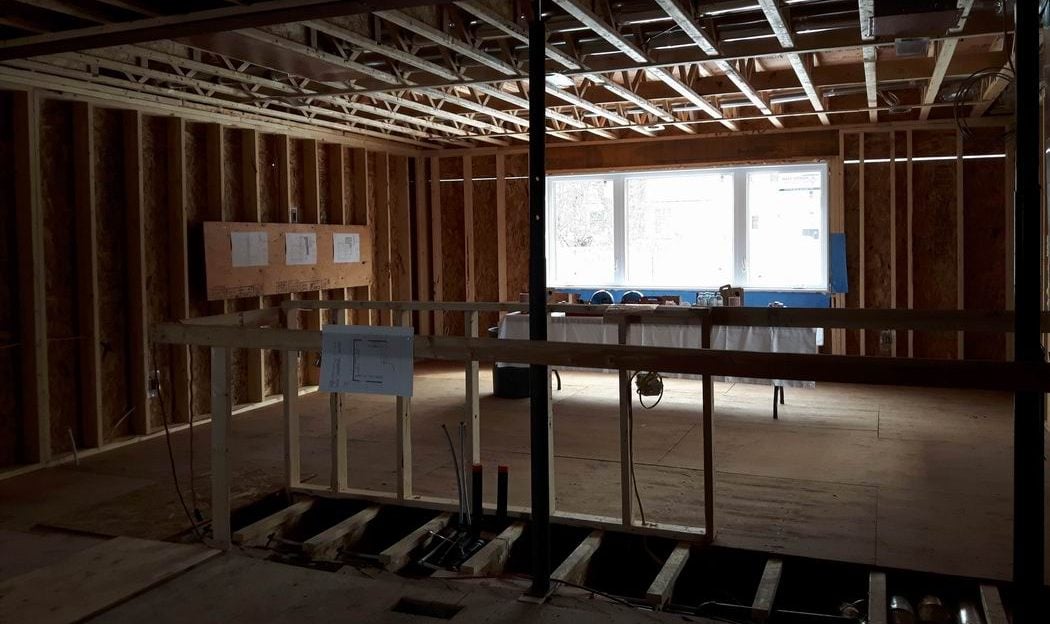We are always told to prepare for a renovation, but that can be more involved than you might think. Decluttering, clearing out and getting organized is an important step in the process — before the construction starts. With that in mind, our staff at Amsted Design-Build have drawn on their experience to create this list of the nine things a homeowner should do to prepare for a renovation.
No. 1: Clear rooms of large and small items
Remove everything from the space being renovated. That includes furniture, decor, accessories, artwork, etc. If you can’t move furniture on your own, ask your renovation team to help you with it.
Wrap your furniture in plastic drop sheets to protect pieces from rips, dust and stains. Smaller items should be put away in bins and boxes in another part of your home.
No. 2: Adjacent rooms
Remove all items from shelving units in rooms adjacent to the reno and cover furniture. Another way to prepare for a renovation: Take photos and other decor off the walls as well. This is a preventative measure to protect them. A spare room is a great place to store all removed items.
No. 3: Protect your valuables
Whether located in the work area or not, any items of monetary value — jewelry, cash, precious metals, even some prescription drugs — should be removed from the home and placed in a safe deposit box. If you have a home safe, store them there. You don’t want to play the blame game with your contractor or their workers, especially if it turns out your child misplaced something.
No. 4: Pets as you prepare for a renovation
If you have a bird or hamster, etc., in a cage in the room that is going to be renovated, relocate it to another room or bring it to a sitter. Cats and dogs should be kept away from the reno area at all times, even at night when no one is around as there could be harmful material that they may ingest. Also, workers should not be asked to watch your pets while they are working in your home and you are at work.
No. 5: Bathrooms
Even though workers are invading certain areas of your home, this does not mean they can go anywhere and do anything. Contractors will usually order up portable toilets for large-scale projects, like building an addition.
But in most other remodeling projects, there will be no toilet. As you prepare for a renovation, it is your decision about whether to allow workers to use yours. If you have a guest bathroom or powder room, it will be to your advantage to “sacrifice it” to the workers during the course of the project.
Tip: Remove towels and replace with a roll or two of paper towels on the sink for workers to use.
No. 6: Prepare for a renovation with schedules
Make sure to talk in detail about what the construction schedule will be like. If you work from home, you may want to work somewhere else for part of the reno, or all of it depending on what is being done.
If workers are on site until 3:30, but your kids are home from school at 3 p.m., see that they have somewhere to go or that you are there to greet them and ensure they don’t run into the construction zone.
No. 7: Prepare your kids
Children react differently to the disruption of renovations, but they will likely be either excited or upset at the prospect of major home improvements.
Elementary school kids are rarely blasé about seeing construction equipment tearing into their backyard or workmen ripping down walls. Some children find the process upsetting because they feel their world is changing around them. Others are so caught up in the thrill of the activity that little else matters to them.
In any case, talk to your children before the project starts, describing the process in general, and stressing that this is all about a positive eventual outcome — a new pool, an addition, a larger living room, new floors — and not about destruction.
No. 8: Being a good neighbour
If you live in a single-family detached home, you probably are not legally obligated to seek approval from your neighbors for your project. Remodeling projects that touch the property line, like fences, are an exception.
If you live in a condominium, you may need to seek approval from the board for remodeling projects within your walls. It is almost certain that you will need approval for projects that involve common (shared) walls or your home’s own interior walls.
As a goodwill gesture, though, you should talk to your adjacent neighbours, informing them of your upcoming plans.
No. 9: Protecting your relationship
If you enter a major home remodeling job knowing that it will put significant strain on your relationship, you are already off to a good start. A remodeling project is a perfect storm where many factors clash: huge cash outlay, mess, diminished privacy. Protect your relationship by keeping the lines of communication open but giving each other ample breathing room when needed.
Once all of this is done, you’ll be ready to go and prepared for a successful renovation!






